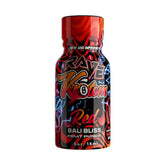Curious about whether kratom shows up on drug tests? You’re not alone! As this natural remedy gains popularity, many people wonder if it can affect their employment or medical screenings. In this article, we'll dive into what kratom is, how it interacts with the body, and whether it can be detected in standard drug tests. Let's clear up the confusion and help you stay informed about kratom and drug testing.
So What is Kratom?
Kratom is a fairly recent addition to Western culture. It comes from a tropical tree found in Southeast Asia and is famous for its stimulating and opioid-like effects. If you're curious to learn more about kratom, feel free to explore our introductory guide to kratom.
Kratom and Its Impact on Drug Tests
To get a clear picture of whether kratom might show up in drug tests, we must cover these points:
- Legal status of kratom
- How drug tests work
- How kratom is processed in the body

Is Kratom Legal?
First off, kratom is legal in most US states, which means it typically isn't included in standard drug tests. Its popularity has been growing recently, so it hasn't been widely tested for in standard screenings yet.
However, it's worth noting that some states and local areas have banned or restricted kratom use.

How do Drug Tests Work?
If you've been researching drug tests, you might have come across terms like '5-panel' and '10-panel.' These are standard tests often used for pre-employment screenings.
What is a 5-Panel Drug Test?
A 5-panel drug test checks for five substances:
- Opiates
- Tetrahydrocannabinol (THC)
- Phencyclidine (PCP)
- Amphetamines (e.g., methamphetamine, Speed, Adderall)
- Cocaine
Less common than the 5-panel, a 10-panel drug test includes these five, plus an additional five substances: 6. Barbiturates 7. Benzodiazepines (e.g., Valium, Xanax) 8. Methadone 9. Methaqualone 10. Propoxyphene
You'll notice that some substances are listed individually while others are grouped together. This distinction is based on how drugs are metabolized in the body. Some drugs have unique testing markers, so they are tested individually, while others are grouped due to similarities in testing methods.

How Does a Standard Drug Test Work?
The first step in a standard drug test involves analyzing a urine sample using immunoassay. This method uses test strips with antibodies to quickly detect metabolites in the sample.
While rapid, immunoassay can sometimes yield false positives. If a positive result occurs, the sample undergoes further testing using a more accurate and specific method.
Typically, the follow-up method involves chromatography-mass spectrometry, a thorough analytical technique. This method, although more time-intensive, is considered the gold standard in chemistry analysis and ensures the accuracy of the initial immunoassay results.
Is Kratom an Opioid?
Have you heard that kratom has effects similar to opioids? Does this mean kratom will show up as an opioid on a 5-panel drug test?
While kratom does activate opioid receptors and is significantly potent (13 times more than morphine), it has enough structural differences from opioids to be classified differently chemically. As a result, it won't trigger a positive result on a standard 5-panel or 10-panel drug test.
Does Kratom Show Up on a Drug Test?
Just because kratom isn’t typically detected on a standard 5- or 10-panel drug test doesn’t mean it can’t be detected at all. If a chemist or testing company specifically looks for kratom, they can find it using advanced methods like chromatography – mass spectrometry. This technique is powerful enough to detect kratom right from the start.

How Does Kratom Show Up on a Drug Test?
After a drug enters your body, it undergoes processing and breakdown. These broken-down forms are called metabolites, and they're what drug tests ideally look for, rather than the original active compounds.
Kratom contains over 25 alkaloids, two of the most important and studied being mitragynine and 7-hydroxymitragynine. Analytical chemists can specifically test for these compounds in biological samples.
However, there are a couple of challenges. Firstly, because kratom is relatively new to the Western market, research on its pharmacology is still limited. This means we don’t fully understand how its active compounds are metabolized. As a result, many current analytical methods for kratom still detect the original forms of mitragynine rather than its metabolites.

The second issue involves mitragynine and its three chemical cousins found in kratom. These four alkaloids share the same chemical formula but differ slightly in their spatial arrangements, a concept termed 'diastereomers' in chemistry.
Why does this matter? When compounds have identical molecular weights, it can be challenging to distinguish them in chemical analysis unless specific methods are used. With the right analytical approach, all four diastereomers can be differentiated and measured individually.
This has both biological and legal implications. Detecting all four diastereomers in a biological sample indicates the compounds originated from a plant source, likely kratom itself. In contrast, identifying only one diastereomer could suggest a synthetic source.
From a legal perspective, this distinction matters because mitragynine is considered illicit in some places, whereas the other three diastereomers are not. If all four are lumped together as mitragynine in testing, it could inaccurately inflate the reported concentration of mitragynine in the person's system.

How Long Will Kratom Show Up on a Drug Test?
The half-life of mitragynine is estimated to be around one day. This means that approximately every 24 hours, the amount of mitragynine in your system decreases by half. While exact data is limited, it's generally believed that mitragynine can be detected in your body for up to a week after consumption.
Several factors influence how long kratom stays detectable in your system, similar to other substances:
- Dosage: Higher doses may remain detectable for longer periods.
- Age: Older individuals tend to have slower metabolisms, potentially prolonging detection times.
- Frequency of use: Regular kratom users may require more time to clear the substance from their bodies.
- Type of test: The sensitivity of the testing method used.
- Body weight and composition: Body fat percentage might affect how kratom is metabolized.
Contact Us For a Free Consultation
If you have any additional questions regarding kratom or any of our other products, please don’t hesitate to contact us for a free consultation.






